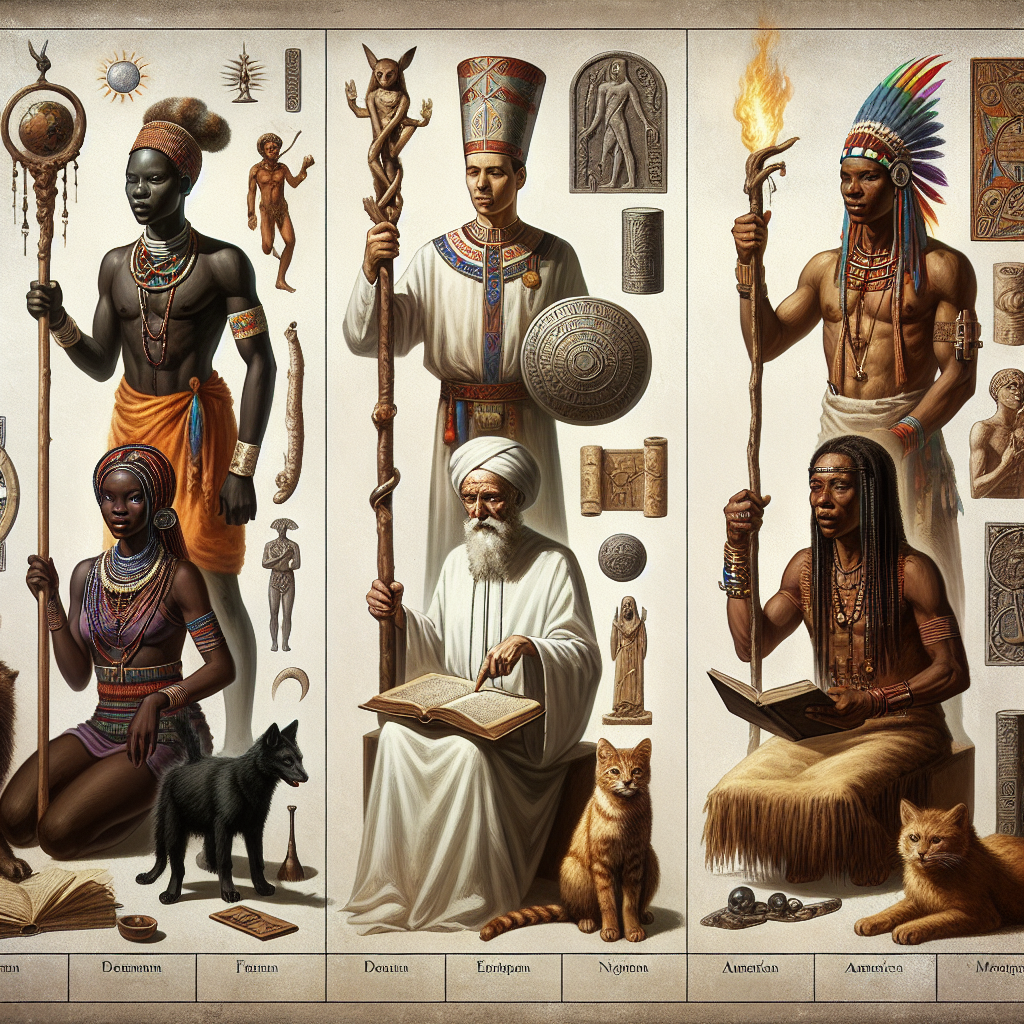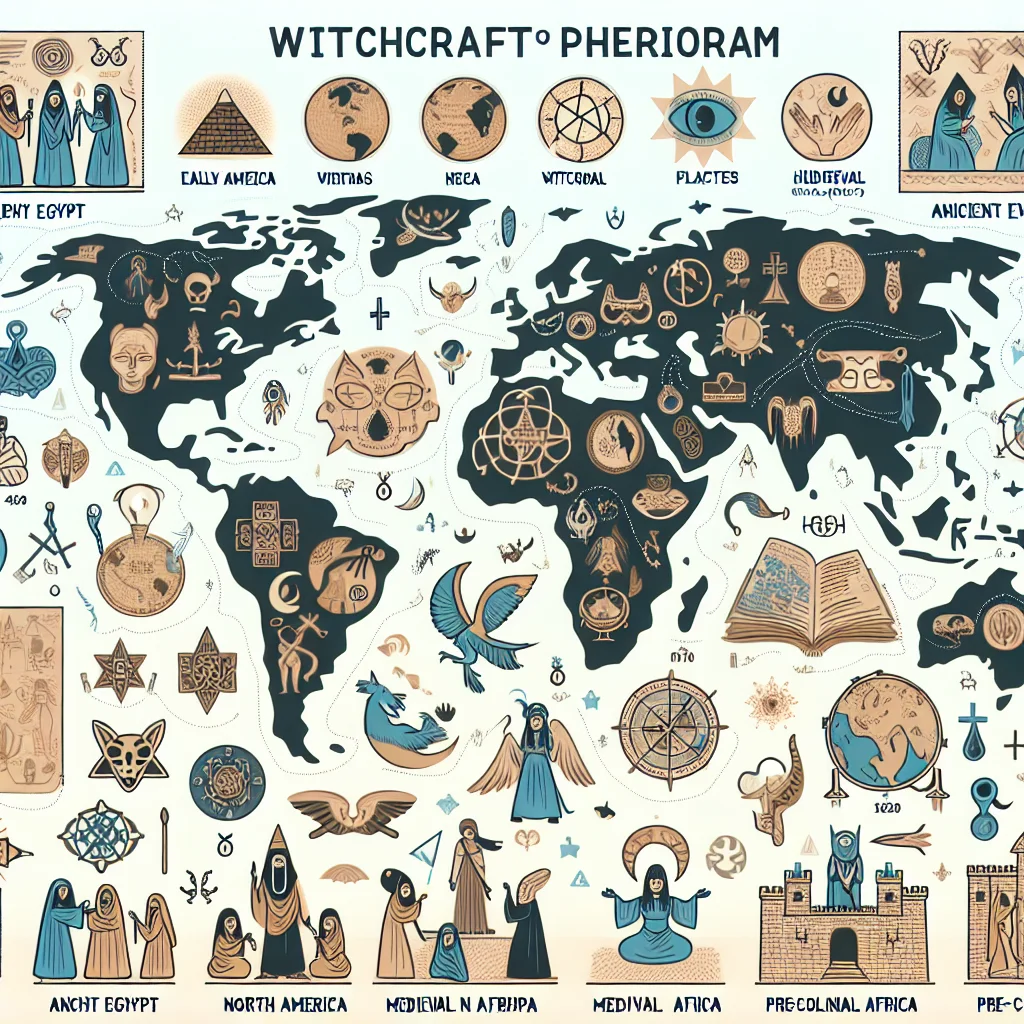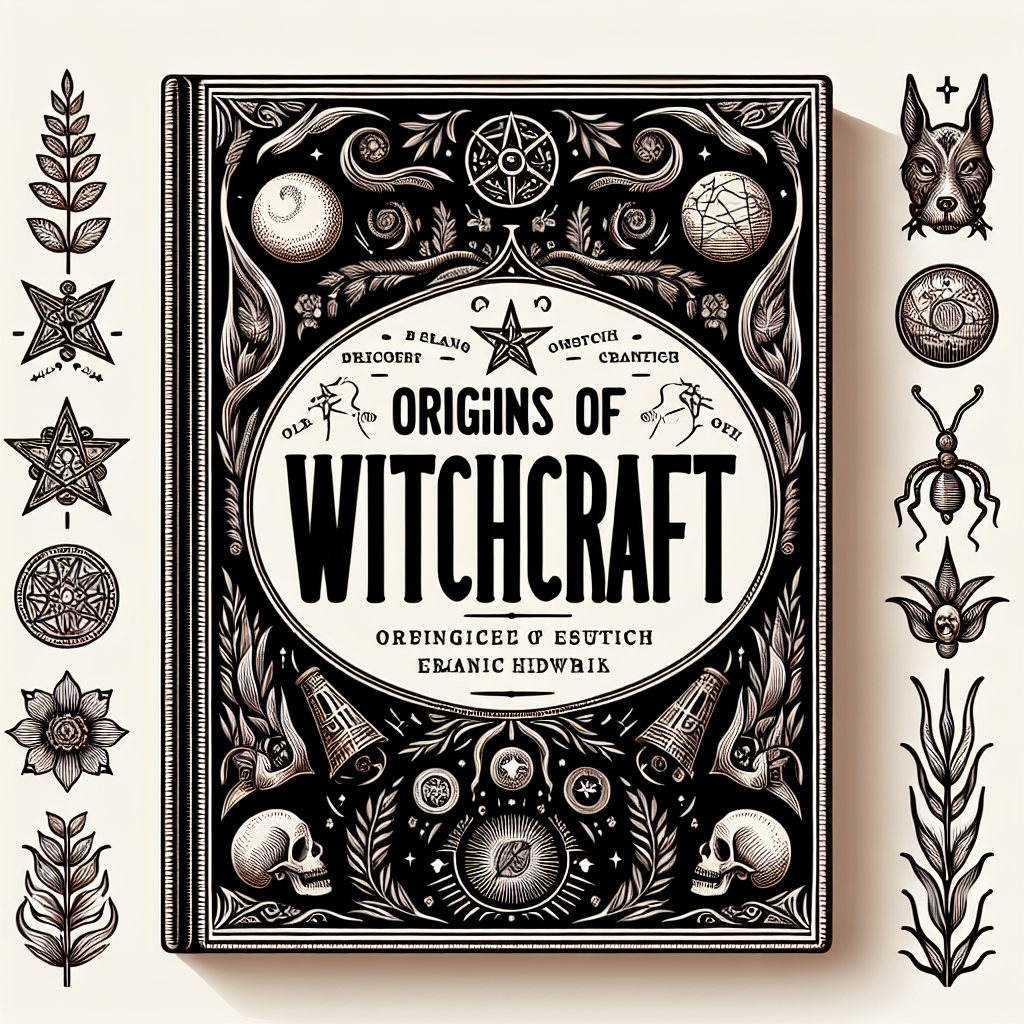As an Amazon Associate I earn from qualifying purchases.

Witchcraft has long been associated with the practice of magical skills, spells, and abilities, often carried out with the aim of causing change through supernatural means. While the concept of witchcraft can be traced back to ancient times, its origins are complex and multifaceted, reflecting a rich tapestry of beliefs and traditions from various cultures around the world.
The history of witchcraft begins in prehistoric times, where evidence suggests that early humans had shamans or medicine men who performed rituals to cure illness, ward off evil spirits, or ensure successful hunts. These spiritual leaders were thought to possess otherworldly powers that connected them with the natural and supernatural worlds. As societies developed, these practices became more codified and began to resemble what we now identify as witchcraft.
In ancient civilizations such as Egypt and Greece, witchcraft was a recognized and often revered practice. Texts from these cultures contain spells and magical incantations which were used to protect, heal, or harm, depending on the caster's intentions. The use of magic was so integrated into their way of life that it was often supported by the authorities and woven into their religious and social rituals.
During the medieval period in Europe, the perception of witchcraft shifted dramatically. Rooted in fear, the Christian Church began to associate witchcraft with heresy and devil-worship. This change marked the beginning of a dark period for witchcraft. The infamous witch trials in Europe and North America, which lasted from the 15th to the 18th centuries, resulted in the persecution and execution of tens of thousands of accused witches. A compelling statistic from this time is that up to 80% of those executed were women, reflecting the gender biases of the period.
In the modern era, the practice and perception of witchcraft have undergone another transformation. Neopagan movements, such as Wicca, have reclaimed the term “witchcraft” to represent a spiritual belief system that honors the Earth and often involves the practice of magical rituals. The contemporary understanding of witchcraft is diverse, with a strong focus on personal empowerment, ecological awareness, and the revival of ancient traditions.
Interestingly, popular culture has played a significant role in shaping the public's perception of witchcraft. From Shakespeare's “Macbeth” to the “Harry Potter” series, the portrayal of witches and wizards has influenced how society views witchcraft, making it a topic of fascination, entertainment, and, at times, controversy. The continued portrayal of witchcraft in media and literature suggests its enduring place in the human imagination and its significance as a cultural phenomenon that transcends time.
“`html
What Are the Historical Roots of Witchcraft? Uncovering the Ancient Beginnings
“`
Witchcraft, often surrounded by an aura of mystery and intrigue, originates from a tapestry of cultural and historical practices dating back to prehistoric times. Its roots can be traced to ancient traditions where magic and the supernatural were integral parts of daily life. Historically, witchcraft was a way for individuals to connect with natural forces and deities, harnessing their powers for healing, fertility rites, and divination. It evolved differently across continents, with notable origins in the shamanistic rituals of tribal societies and the classical witch figure from the folklore of medieval Europe. In this intricacy, witchcraft has been both revered and feared, leading to its complex societal status throughout history. To delve deeper into the evolution of witchcraft and how its practices have unfolded over the centuries, join us in the following discussion where we uncover the nuances of this enigmatic phenomenon.
The very origins of witchcraft are shrouded in the mists of time, with roots that twist and sprawl deep through the soils of history, anthropology, and spirituality. To answer the question “where did witchcraft originate?” one must first understand that witchcraft, as a practice involving magic or supernatural abilities, has manifested diversely across different cultures and epochs, so pinpointing a singular origin is not straightforward.
Prehistoric Beginnings and Shamanism
The earliest signs of behaviors that could be considered witchcraft date back to prehistoric times when shamanism was practiced by tribal societies around the world. Shamanic traditions, involving communication with the spirit world often through altered states of consciousness achieved by rituals, dance, or the consumption of entheogens, are seen as the precursors to what would later be termed witchcraft. These practices were integral to the communities, with shamans acting as healers, guides, and mediators between the physical and spiritual realms.
Ancient Civilizations and Magic
In ancient civilizations, such as Egypt, Greece, and Babylonia, magic was an accepted and integral part of religion and daily life. The Egyptians, for instance, used magical spells and rituals for protection, healing, and to ensure a safe passage to the afterlife. Similarly, in Greece, magic was associated with figures like Circe and Medea, mythological witches who represent early examples of the magical practitioner archetype. Practices considered as witchcraft were typically a blend of lore, ritual, and herbal knowledge, passed down through generations.
Middle Ages and the Witch Hunts
As Christianity spread across Europe during the Middle Ages, the church's stance against paganism and heretical behaviors led to the demonization of pre-Christian practices, which increasingly became associated with witchcraft and heresy. The infamous witch hunts, peaking during the 15th to 17th centuries, saw thousands of individuals—mostly women—executed for alleged witchcraft, a tragic consequence of fear, superstition, and religious zealotry. The witch trials most famously included the Salem witch trials in colonial Massachusetts, among others across Europe.
Modern Revivals and Wicca
The 20th century witnessed a revival of interest in witchcraft, culminating in the creation and growth of Wicca. Started by Gerald Gardner in the 1950s, Wicca is a modern pagan, witchcraft religion that draws upon a diverse array of historical and cultural sources, including ceremonial magic, the Hermetic Order of the Golden Dawn, and folk ritual. Contemporary witchcraft, while diverse, often emphasizes a connection to nature, the practice of magic, and the worship of a Goddess (and sometimes a God), harking back to the earlier pagan traditions.
Contemporary Witchcraft as a Global Phenomenon
Today, witchcraft is practiced and understood in numerous forms around the world, reflecting an organic synthesis of past and present beliefs. It spans solitary witches practicing eclectic magic at home, through covens that gather to perform rituals, to indigenous cultures maintaining their ancestral shamanistic practices. Modern witchcraft is characterized by its breadth and depth, with some practitioners keeping close to traditional paths while others innovate and adapt practices to suit contemporary life.
Statistical Recognition and Growth
What began in disparate places across the globe has coalesced into a recognized spiritual path. According to the Pew Research Center, as of 2014, Wicca and other Pagan faiths were experiencing rapid growth, with an estimated 1 to 1.5 million practitioners in the United States alone. This figure reflects only a fraction of those practicing forms of witchcraft worldwide, as many practitioners do not subscribe to organized religion, and many countries have diverse spiritual practices that could be classified under the broad umbrella of witchcraft.
In conclusion, the origins of witchcraft cannot be tied to a single location or era. Instead, it is a complex tapestry woven from humanity's earliest spiritual endeavors, continuously evolving alongside societies and personal spiritual paths.
1. What is the definition of witchcraft?
Witchcraft refers to the practice of magical skills, spells, and abilities by individuals, known as witches. It has various manifestations across cultures, often involving the use of supernatural or mystical powers. It can be understood differently, ranging from malevolent sorcery to nature-based pagan practices.
2. In which region of the world did witchcraft originate?
Witchcraft as a concept does not have a single point of origin; it has been present in various forms across many different cultures worldwide. Some of the earliest records of practices resembling witchcraft can be traced back to ancient civilizations like Egypt and Mesopotamia.
3. Did witchcraft have a single founder or originator?
No, witchcraft did not have a single founder or originator. It developed independently within different cultures, with each society forming its unique practices and beliefs related to magical practices.
4. How did ancient civilizations view witchcraft?
Ancient civilizations had varied views on witchcraft. In some societies, individuals believed to possess magical powers were revered and respected, while in others, they were feared or persecuted. The perspectives were often tied to the belief systems and religions of the time.
5. Are there any historical texts that provide information on the origins of witchcraft?
Yes, there are historical texts such as the “Egyptian Book of the Dead,” and various Mesopotamian tablets that provide insights into early magical practices. The documentation of witchcraft became more prevalent during the medieval and Renaissance periods in Europe with texts like the “Malleus Maleficarum.”
6. Was witchcraft always associated with evil?
No, witchcraft was not always associated with evil. The perception of witchcraft as a malevolent force is largely a product of Christian influence in medieval Europe. In many cultures, witches and practitioners of magic were seen as wise healers and protectors.
7. How did the witch trials affect the public perception of witchcraft?
The witch trials, especially during the 16th to 18th centuries in Europe and North America, significantly affected public perception by associating witchcraft with evil, devil worship, and malevolent sorcery. This led to widespread fear, discrimination, and the execution of many accused witches.
8. Are modern forms of witchcraft connected to ancient practices?
Modern forms of witchcraft, like Wicca and other neopagan movements, draw inspiration from ancient practices but are not direct continuations of them. They have reconstructed or reimagined elements of old beliefs and rituals to fit contemporary spiritual needs.
9. Is witchcraft recognized as a religion?
Some forms of modern witchcraft, such as Wicca, are recognized as religions. Wicca, for instance, is a legally recognized religion in several countries and involves the worship of a goddess and a god, and the observation of seasonal festivals and rituals.
10. Can witchcraft be practiced by anyone?
In principle, witchcraft can be practiced by anyone interested in learning and engaging with its beliefs and methods. However, some traditions may have specific initiations or teachings that require guidance from experienced practitioners. As with any spiritual or religious path, respect for its history, culture, and beliefs is essential.

Conclusion
The exploration of the origins of witchcraft reveals a complex tapestry woven from various cultural, religious, and historical threads. As discussed, the earliest indications of witch-like practices can be traced back to prehistoric times, where shamanism and animism laid the groundwork for what would evolve into the witchcraft that permeated ancient civilizations. In these societies, such as those of Sumer, Babylon, and Egypt, witchcraft was intertwined with religion, magic, and the supernatural. It served as a means to explain the unexplainable, to harness unseen forces, and to provide solutions to everyday challenges. Witchcraft in this era was not the malevolent force it would later become in medieval Europe, but rather a respected and integral element of spiritual and communal life.
The transformation of witchcraft's image occurred during the rise of monotheistic religions, notably Christianity. As powers centralized and religious dogma sought to rout out heresy, witchcraft was cast as a diabolical art. This malign interpretation of witchcraft, culminating in the infamous witch trials and mass hysteria from the 14th to 17th centuries, starkly contrasts with its earlier roots. Yet, despite this dark period, witchcraft endured, metamorphosing yet again into various modern forms, from the Wiccan religion to eclectic magical practices. Thus, from its nebulous beginnings to its contemporary renaissance, witchcraft remains an enduring symbol of humanity's quest to understand the mystical, to control the elements around us, and to assert autonomy over personal spirituality.
Amazon and the Amazon logo are trademarks of Amazon.com, Inc, or its affiliates.


